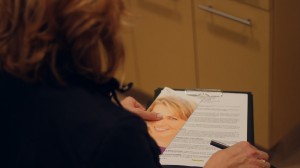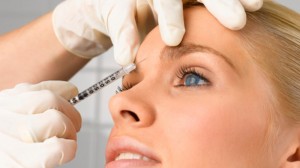Thoughts of stem cells are often associated with controversy thanks to some narrowly focused media campaigns. Stem cells exist throughout the body, throughout the life of the individual. Cutting edge science is discovering the abundance of stem cells that exist in the fat just under the skin of every adult.
Plastic surgeons have become quite familiar with the characteristics of subcutaneous fat and new techniques allow surgeons to use a patient’s own fat as a substitute for synthetic fillers. Dr. Peter Fodor, a board certified plastic surgeon from Beverly Hills, recently began a study to look at how adult stem cells (removed from fatty tissue via liposuction) help people suffering from poor knee strength, a study that may eventually bring these “magical” cells into aesthetic medicine.
By: Peter B. Fodor, MD
and Chris Knisley
ThePlasticSurgeryChannel.com
![knee-joint]() Ahead of the Curve
Ahead of the Curve
“We found that subcutaneous fat (fat under the skin) is abundantly rich in stem cells,” says Dr. Fodor. “Two to three hundred times more per volume than bone marrow.”
Dr. Fodor says that stem cells have an innate ability to seek out the source of injury. They act as a sort of white blood cell, capable of repairing and conforming to any part of the body. The study, to which Dr. Fodor refers, focuses on stem cell injections into the joints of the knee.
The knee, one of the simplest joints in the human body, serves as an optimal site for these early experimentations.
Medical Use
The direct injection of stem cells results in an overall improvement of symptoms. Pain is decreased while mobility is increased. Stem cells are also responsible for new cartilage growth, “which is mind-boggling,” says Fodor. “Nothing else has been able to do this.”
Patients’ symptoms are disappearing with such quickness that Dr. Fodor finds himself telling patients to slow down, reminding them not to overdo it despite a sudden dissipation of pain.
Aesthetic Use
 Plastic surgeons are already using patients’ own subcutaneous fat to augment certain elective surgeries. Procedures involving the breasts and buttocks are increasingly eschewing the use of synthetic technologies in favor of this natural alternative.
Plastic surgeons are already using patients’ own subcutaneous fat to augment certain elective surgeries. Procedures involving the breasts and buttocks are increasingly eschewing the use of synthetic technologies in favor of this natural alternative.
Augmentations and reconstructions are both benefiting from an organic solution that seems to take a lot of the guesswork out of the equation. Personal, living cells are effectively allowed to re-invigorate tissue that may have been the target of degeneration.
It seems that the growth of new life can find its inspiration in the injection of a particularly reliable aspect of old life – life that has always been there, just under the surface.
The use of one’s own stem cells, empowered with regenerative abilities, is a major breakthrough in aesthetic plastic surgery, as well as in reconstruction.
The post Adult Stem Cell Study: Healing Up Battered Knees appeared first on The Plastic Surgery Channel.
 Ahead of the Curve
Ahead of the Curve
 The Icing on the Cake
The Icing on the Cake

 What A Man Needs
What A Man Needs


 “We discourage our patients from simply signing a document without reviewing it thoroughly,” says Beverly Breshers, LCPME, at Somatique Medical in Dallas, Texas. “We want all patients to feel comfortable with the consent form prior to any type of procedure.” Consent documents are used to outline the procedure’s risks and explain alternative treatments.
“We discourage our patients from simply signing a document without reviewing it thoroughly,” says Beverly Breshers, LCPME, at Somatique Medical in Dallas, Texas. “We want all patients to feel comfortable with the consent form prior to any type of procedure.” Consent documents are used to outline the procedure’s risks and explain alternative treatments. Map Out the Face
Map Out the Face



 “Lots of injectable patients are actually great candidates for combination therapy where we use Botox in certain areas and fillers in another area,” explains
“Lots of injectable patients are actually great candidates for combination therapy where we use Botox in certain areas and fillers in another area,” explains 
 How does micro-needling work? In essence, a pen shaped device studded with fine needles penetrates the upper layers of the skin creating tiny holes in the skin’s surface. In response to the “needling” the body creates new collagen and elastin fibers, plumping and thickening the skin. Dr. Stafford Broumand who practices in New York City describes the procedure as a “new tool” that revolutionizes how compounds are
How does micro-needling work? In essence, a pen shaped device studded with fine needles penetrates the upper layers of the skin creating tiny holes in the skin’s surface. In response to the “needling” the body creates new collagen and elastin fibers, plumping and thickening the skin. Dr. Stafford Broumand who practices in New York City describes the procedure as a “new tool” that revolutionizes how compounds are  Micro-needling is done in a doctor’s office. Numbing cream is applied and is usually sufficient to ease any discomfort. The procedure generally takes less than an hour and downtime is short. Apart from some mild swelling and redness, there are few side effects. On average, most patients repeat the procedure 3 times on a 4-6 week schedule until they achieve desired results. Full effects are seen 3 to 4 months post procedure.
Micro-needling is done in a doctor’s office. Numbing cream is applied and is usually sufficient to ease any discomfort. The procedure generally takes less than an hour and downtime is short. Apart from some mild swelling and redness, there are few side effects. On average, most patients repeat the procedure 3 times on a 4-6 week schedule until they achieve desired results. Full effects are seen 3 to 4 months post procedure.























